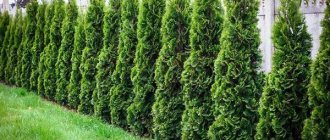Natalya Popova Knows how to care for thuja
The most striking representatives of the cypress family in central Russia are thujas of various varieties and species. All of them have attractive characteristics: thuja is easy to care for, does not require frequent pruning, and demonstrates good frost resistance.
In spring and summer, thuja requires practically no attention. All the plant needs is rare watering and moderate feeding. But caring for thuja in the fall - preparing for wintering - requires more attention. I'll tell you what to do.
How to protect conifers from the sun. Conifers and wintering - what we cover and what we don’t
It is with great pleasure that I write again and again about my favorite coniferous plants - this is my favorite part of the garden and a respite from the daily hustle and bustle. I have about forty different types of conifers. And there are many varieties that vary in shape, color, crown structure, growth rate, and so on. In general, each plant is unique and requires care. Here are all the types of coniferous plants that are present on our site.
Mountain pine, Chinese juniper 'Old Gold', thuja globulus, Korean fir 'Emperor Blue', cushion spruce 'Nidiformis', pea cypress 'Filifera' All of them, as well as any others, while they were babies, took refuge at first wintering. Except for the pea cypress, which I covered for several years in a row, then forgot about it some year - but it withstood all the hardships remarkably well, since then I have not covered it. And now I would like to share with you my observations and a little experience in preparing conifers before winter and early spring. For me and my coniferous pets, the main worry during this period is the aggressive spring sun, which leads to burns of the crown. This can happen at the end of winter, but for objective reasons related primarily to weather conditions and the inability to come to an already mothballed dacha again and again, I cover my conifers that are especially sensitive to the sun in advance, when I finally move out of the dacha. That is, the end of October - the beginning of November. And who are they, so susceptible to the spring sun in my region? These are cypress trees, konica (Canadian spruce) and certain varieties of juniper - blue, bluish, gray... and prickly. So we’ll talk about them. Cypress - they sold it to me as a thuja, since then I haven’t bought anything at exhibitions. The top is no longer there - it burned down when I didn’t cover it before winter.
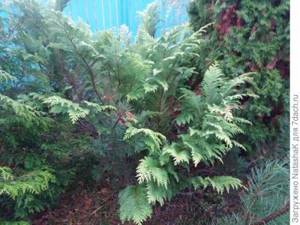
Cypress Last year I didn’t cover it, but this year I decided to wrap it up - it’s a pity, the color is very beautiful.

Covered cypress Next we move on to conika - it is also known to everyone as Canadian spruce. In March it burns mercilessly, and mine is also half blue.
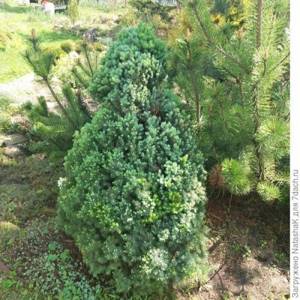
Konika This is how we wrapped her up again this year.
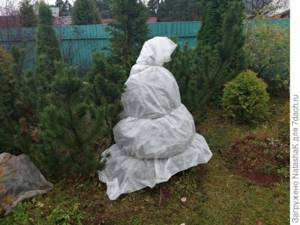
Konika is ready for the spring sun. On the left in the photo you can see how the amazingly beautiful, but absolutely no desire to grow, juniper 'Blue Star' is covered in our country. I’m not providing a photo, it’s just wasting away, I’ll carry out an intensive course of treatment in the spring. There are also three “suspicious” specimens on the hill and around it... This is a creeping Cossack juniper. It’s so gray-blue, I bought it in a mix, without a name, of course. Identified as 'Blue Capet'...
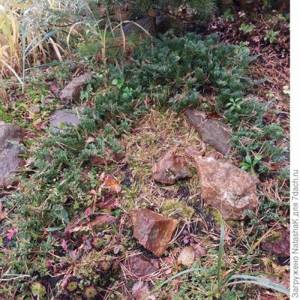
Cossack creeping juniper I cover it just in case.

The Cossack creeping juniper is covered. And below I have two more “suspicious” junipers.

Juniper creeping 'Variegata' - very prickly, can catch sunburn
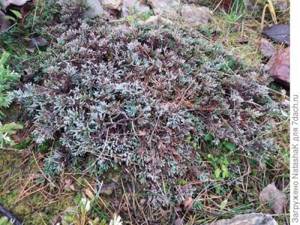
Creeping juniper 'Viltoni' I could have made a mistake with the names, again, I bought it in a mix. I cover this couple together.
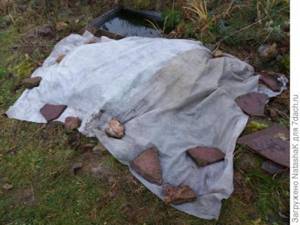
Two junipers under cover The cover seems to be all... But there are conifers whose crown is very deformed under the snow. I have a columnar juniper and one of the spherical thujas. I just tie them - if a sea of snow suddenly falls, the crown will be fine.
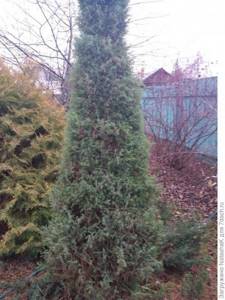
Unfortunately, I don't know the name...

Spherical thuja with a “loose” crown That, perhaps, is all about preparing my “park” of conifers for wintering. I hope that they will all be comfortable, despite the vagaries of the weather. And I wish all the best to all your coniferous pets!
Preparing thuja for cold weather
The crown of the tree needs to be insulated no less than the rhizome, because in winter it is subject to severe frosts.
During snowfall, branches break off under the weight of the snow. And on too sunny days, at the end of winter, the foliage can get burned, after which the thuja will turn yellow.
It is due to ignorance and inexperience that novice gardeners lose young trees after wintering, covering them incorrectly, or not covering them at all.
It is important to know that you should not wrap thuja for the winter with polyethylene, too thick fabric or an old blanket. Because condensation will certainly form inside it
And because of this, the tree will freeze at the slightest frost.
Covering material for thujas should only be light in color. This way it can reflect the bright winter sun without creating too much shade for the plant itself.
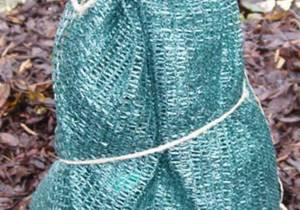
If a tree or bush is covered with cloth, it must be non-woven. Some people use thick wrapping paper. It is good because it allows oxygen to pass through itself. And on a frosty day, it will protect the thuja.
Also, for shelter you will need a strong rope, a stapler and wire.
How to insulate thuja? There are three ways to protect a tree in winter:
using gauze - first, the tree branches are folded towards the middle and very carefully tied with a rope. Now, you need to take a large piece of gauze fabric and wrap it around the tree in a circle
But you should know that when wet, the gauze will shrink. Therefore, take extra fabric. The finished winding is secured with rope, wire or a stapler, whichever is convenient for you. using burlap - take burlap, only a light color and the right size so that the tree does not feel embarrassed. Then, the branches are still tied together with a rope, a bag is put on, and secured from the very bottom. using a frame - here you will need to work hard. This method of insulation is suitable only for shrubs and low trees. You can make a frame from wire or wooden slats.
The shape of the frame should be pointed towards the top, otherwise the ball of snow will simply crush the bush. Then protective material is put on it and secured at the bottom.
You can make the frame yourself, or you can purchase a ready-made one in a specialized store.
Very small trees, which are not even a year old, are covered for the winter using five liter plastic bottles
To do this, cut off the bottom and very carefully place the bottle on the seedling. The edges of the bottle should touch the ground itself
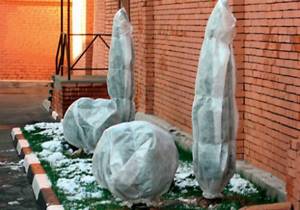
Having covered the thujas, winter care for them does not end there. After heavy snowfalls, snow must be cleared from the tops of trees and bushes. It is also worth clearing the ground from snow, near the tree itself.
Features of care in winter
Complete adaptation of a young thuja to weather conditions will take 2-3 years.
Despite all its unpretentiousness, the tree requires careful attention and proper care. In winter, these representatives of the coniferous family especially need care.
Preparation for the winter period should take place before the onset of cold weather and snowfall (in late autumn, depending on the region of growth). First you need to carry out a number of works:
- Near the tree trunk you need to lay a decent layer of mulch made from tree bark and nut shells. In winter, it will rot and, accordingly, release heat.
- The root collar of a coniferous plant also needs to be insulated and hilled, covered with a decent layer of peat or compost.
- Then the thuja must be watered well.
- An adult plant is tied with a rope so that it does not break under the weight of wet snow.
Then the tree needs to be covered so that it can withstand the frosty winter. The plant is also wrapped in order not to expose it to attack by small rodents and the influence of sunlight.
To do this, you need to prepare a special covering non-woven material or spruce branches. It is not recommended to use materials that do not transmit light, since photosynthesis in this plant also occurs in winter.
Mature trees do not need to be covered. Since they are able to independently survive the cold and the onslaught of the sun.
How to preserve conifers in winter. Conifers: how to prepare for winter and protect them from the vicissitudes of the weather
Experts advise purchasing only winter-hardy species and varieties of conifers, but to know what surprises the next winter will bring us! In an unfortunate set of circumstances, any coniferous plant can suffer if it is not properly prepared for winter.
When preparing coniferous plants for winter, be sure to carry out moisture-recharging irrigation, protect new plantings from direct sunlight, and protect plants with spherical and conical crowns from breaking by snow. So, what exactly needs to be done in the garden when preparing coniferous plants for winter.
Moisture-recharging irrigation
At the end of leaf fall, water the coniferous plants well at the root (5–8 buckets per plant). Don’t waste time on forest trees and old, time-tested trees: they have developed roots and will take care of themselves. Watering before winter is desirable for all plantings made in the past and current seasons; for varietal specimens and exotics, regardless of the time of planting (there are also very resistant ones among them, but if you are a beginner gardener, it is easier to water everything than to sort it out - there will be no harm from this).
The crown of conifers wakes up early, often when the roots cannot yet provide it with moisture due to frozen soil. Hence, burning of needles is a common problem in the middle zone. Well-moistened soil freezes to a shallower depth, which reduces the risk of spring damage.
Consolidation of new plantings
The crown of a coniferous plant collects a lot of snow. If there is heavy snowfall at above-zero temperatures, such a snow mass may stick to the branches that the seedlings that have not had time to take root will be uprooted. After freezing rain, even small plants, up to a meter tall, fall and tilt. In anticipation of snowfalls, thoroughly secure all plantings of the current year with guy wires to prevent even small movements: because of them, small roots are torn off and the survival period of plants is delayed.
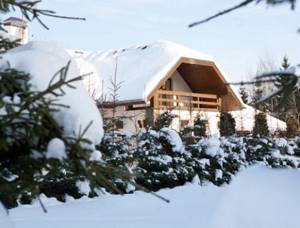
Columnar junipers, cypress trees, varieties of thuja, the crowns of which burned in past years, and all varieties of Canadian spruce need to be additionally protected from sunburn with a shelter. They are not suitable: solar heat accumulates under them, and this is exactly what we do not need. The purpose of the shelter is to shade the crown and prevent it from heating up. Burlap, a special mesh or even woven polypropylene panels perform this function well. They are placed on the plant and tied with twine (do not pull the branches too tightly!). Do not try to wall up the crown tightly - let the “vents” remain. Large specimens need to be shaded only on the south side.

In the photo: Protecting thuja from sunburn

In the photo: Tui suffering from sunburn
Crown tying
For varieties of thuja and young pines that are resistant to the spring sun, which you do not intend to shade from burns, do not tie the branches tightly so that under the weight of snow or (God forbid) they do not bend or break. In some years, even local forest pines suffer from snowbreaker.
What to do, if…
No precaution provides complete protection from bad weather. Therefore, it is useful to know what to do if:. … a lot of sticky snow fell
… a lot of sticky snow fell
Use a pole or board wrapped in soft cloth to knock snow off the branches. Do not shake the trees, do not hit them with all your might: tap them often with small jolts so as not to damage the bark and the branches themselves (in winter they lose their elasticity and break easily).
... it was freezing rain
Using supports and ties, try to give the branches their original position. Do not try to melt the ice on the branches with a hairdryer or warm water - the buds may wake up prematurely from the heat, and a new one will be added to the already existing problem. The ice will melt off on its own with the onset of sunny weather, even if the air temperature is still negative.

In the photo: Icy rain on coniferous plants
... in the spring the needles on the plants turned yellow or discolored
Having noticed this, immediately shade the crown by first spraying it with water if the weather is sunny. Water the affected plant with warm water. If the water spreads without being absorbed, then the soil is still frozen. Then water several times a day in small portions. When the daytime temperature steadily rises to +10°C, treat the crown with Epin, Zircon or NV 101.
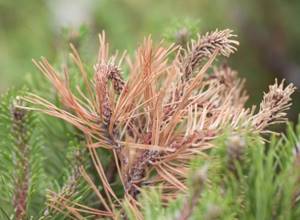
Plant care
Caring for thuja in spring and summer is not particularly difficult. If you follow all the recommendations, the plant will not get sick and will tolerate unfavorable climatic conditions. Its condition depends on how to care for the thuja.
Landing
These trees produce seeds. They have cones, each of which contains seeds. They ripen by autumn and at this time are already suitable for reproduction. A seedling grows from a seed. It has been growing for 5 years. During this time, the plant adapts to harsh winters. Seeds can also be grown at home in a pot.
Choose a sunny place for planting. The soil must be nutritious. Seeds are best planted in spring. The depth at which the seeds should be located is no more than 5 cm. The place where this coniferous tree is sown should be sprinkled with a small layer of sawdust from pine needles.
Young shoots will grow from these seeds. They should be protected from direct sunlight. When weeding, you need to be very careful because the young shoots are very tender.
Note! Seedlings may die in direct sunlight, so planting sites should be shaded. The soil under these plants needs to be loosened and constantly moistened.
The shoots need to be fed with slurry and manure. To prepare it, manure should be diluted in water (per 1 liter of water - 50 g of manure)
The soil under these plants needs to be loosened and constantly moistened. The shoots need to be fed with slurry and manure. To prepare it, manure should be diluted in water (50 g of manure per 1 liter of water).
Reproduction by shoots
Thuja can reproduce using shoots. To do this, you need to prepare cuttings from shoots that are 2, or even better, 3 years old. An annual shoot can also be planted, but it must have a piece of old wood. The cuttings are treated with a special preparation - heteroauxin.
For better rooting of cuttings, you need to use turf soil and peat. Cuttings are planted to a depth of no more than 2.5 cm. It is best to care for them in a greenhouse (in these conditions they can be protected from direct sunlight).
Watering
Gardeners are interested in how often to water thujas. For plants planted in the warm season, watering the thuja is required once a week (if the weather is not hot). If the air is very dry and hot, watering becomes more frequent up to 2 times a week. Under each bush you need to add at least a bucket of water.
During the first month of life, the plant needs to be rained. With this type of watering, the pores open and the tree begins to breathe. The trees need to be irrigated once a week. Its further growth depends on how to water the thuja.
Starting around August, watering does not stop. It is needed for the plant to gain moisture for a good winter.
Important! Excessive watering is no less humid - the plant does not like it and can develop fungal pathology. How often to water thuja after planting in summer determines its resistance to fungal diseases
Top dressing
Gardening enthusiasts are interested in what to feed thuja in the summer.
When feeding, you should pay attention to the following recommendations:
- Fertilizing is done only in spring and summer; at other times it is not advisable to do this.
- It is recommended to use the Zircon solution, which has a beneficial effect on the growth processes of the root system and the absorption of useful components by the tree.
- In spring, it is recommended to spray trees with Iron Chelate. It prevents the development of chlorosis.
- When growth intensity decreases, Megafol and Vermiculite are used.
Loosening, mulching
It is necessary to loosen the soil near this plant to a depth of at least 10 cm. This is due to the location of the plant’s root system.
Haircut and trimming
Methods of caring for thuja in summer involve mulching. It is carried out using peat. Its layer should not exceed 7 cm.
Haircut and trimming
In order for the tree to develop properly and have a beautiful crown, it needs to be pruned. Most species acquire one form of crown or another as they grow. By trimming you can give it the desired look. Sanitary pruning is required if yellow, damaged branches appear.
The frequency of pruning depends on the intensity of growth (it does not exceed 35 cm per year, in some varieties it reaches 10 cm per year). The timing of crown formation is regulated as follows:
- When the buds open - approximately 10 days after the average temperature outside has reached 10 degrees.
- During flowering, shoots are pruned in the northwestern region - at the end of May or early June, in the middle zone - in mid-May, in the south - in April.
Important! If you prune the thuja before it begins to bloom, you can stop its growing season
Pruning branches
In spring, pruning dry, old and diseased branches will be very important.
The update will benefit the plant and allow healthy shoots to grow well and develop steadily. The first pruning should be done 2-3 years after planting.
To maintain the beautiful shape of the branches without leaving creases and dents, it is better to use a large pruner. This should be done in the early summer period, when the branches and buds are finally formed.
The next pruning should be done at the end of August, and in the interim, after waiting until the tree reaches the required height, you can adjust the crown. In this case, it is better to cut off no more than one third of the shoot, so as not to weaken the plant.
Pruning thuja also has an aesthetic meaning; with its help, the tree can be given the necessary shape, this is especially true for creating a hedge.
At first, the young thuja will especially feel the change of seasons, so after wintering its needles may fall off, turn yellow and dry out. With proper care, these phenomena will disappear, and the tree will successfully adapt to the climate.
How to restore thuja after winter, see the following video:
Each plant is a living organism that requires an individual approach to the selection of activities aimed at caring for it. Some plants need to be given a minimum amount of time, they are unpretentious and will not require much expenditure from you.
And there are plants that are not so easy to grow. For example, caring for a thuja in winter consists of a set of measures that it is advisable to carry out in full in order to keep the plant healthy and beautiful.
It is this issue that we will pay attention to in this article, because thuja is one of the most popular species that many gardeners prefer to use in landscape design.
Thuja shelter for the winter: what you need to know
Thujas outdoors can easily withstand frost without shelter, but for regions with cold winters, where temperatures drop below -30-35 degrees, protection is required. The same applies to recently transplanted, young and growing specimens in an open area.
Thujas are covered for the winter simultaneously with the onset of stable cold weather - the thermometer should be between +4 and -2 degrees. The root system should already be protected from November frosts - to do this, it is enough to mulch a trunk circle 1 m in diameter with fallen leaves with the addition of dry grass, peat and other rotted organic matter.
Circular strapping
Circular tying is the easiest way to cover thujas for the winter, which is suitable for young or short specimens growing in areas with light snowfall:
- the bush is carefully wrapped with twine from the bottom up and in the opposite direction, so that the side branches are bent to the trunk;
- the tree is tied with a covering material that allows air to pass through (spunbond, agrofibre, burlap, agrospan, etc.), which is additionally secured with a rope.
Circular tying can be used not only to protect against the cold, but also to prevent branches from breaking off under the weight of snow. Since, as a result of fixation, the thuja acquires a dome shape, precipitation will smoothly slide down without damaging the shoots. It is advisable to carry out the procedure before the start of active snowfalls.
Shelter with frame
Young or short varieties of thuja, grown in regions with heavy snowfalls, tolerate wintering well in a shelter with a frame:
- a frame is formed from several metal or wooden crossbars, which must be tied crosswise over the top of the thuja;
- the frame is tied with covering material that allows air to pass through;
- The shelter is fixed to the frame using twine or wire.
It is necessary to remove the frame with the onset of stable heat, but do not delay it so that the thuja does not freeze from moisture.
Application of ready-made cases and protective screens
Covers to protect thujas from snow are suitable for gardeners who do not want to waste time building a shelter. It is enough to buy a finished product, choosing an option taking into account the size of the specimen, and then put it on the bush, after tying the branches.
Ready-made covers will prevent plant death from extremely low temperatures, snow and freezing rain.
The protective screen will prevent spring fading of the thuja upon contact with the sun's rays, which often cause the loss of decorativeness. It's quite simple to build - you just need to stick a couple of thick metal rods into the ground or hammer poles in front of the bushes, and then put up boards or stretch covering material. The screen should create a shadow during peak solar activity, so be sure to consider the direction of the rays.
It is advisable to use a protective screen both for young seedlings and for adult thujas, the needles of which may be damaged by the sun.
Features of shelter in different regions of Russia
It is necessary to cover thujas for the winter, taking into account the climatic characteristics of the region, especially the timing of active snowfall. For the Moscow region and other areas of the middle zone, work is carried out in the second half of October and November; for the Urals and Siberia, the dates are shifted closer to September.
The covering method also depends on the climate, which affects the degree of insulation of conifers. For the Moscow region, it is enough to mulch the tree trunk circle and protect the bush with covering material. For the Urals and Siberia, such shelter is not enough - in severe winter conditions, plants simply will not survive under thin agrofibre or burlap if a significant amount of snow falls. In cold regions, thujas are protected with a frame that prevents damage to the branches from the accumulation of snowdrifts, harsh winds and extreme temperatures.
Proper preparation for winter followed by shelter will help protect young thujas from bad weather and frost, and prevent adult specimens from freezing out in the northern regions.
Methods
Preparation of thuja for winter begins in the fall, before the first frost and snow. The simplest option is bags of a suitable size, which are secured with twine. It is enough to wrap an adult plant with strong roots with a strong rope. Another way to cover tall varieties of thuja involves constructing a frame. It’s not difficult to make – just drive three metal pins over the top of the thuja (crosswise) and secure it. Then cover the frame with non-woven material. Special shields that create shade will provide excellent protection from the spring sun. Low-growing bushes can be covered with wooden boxes. Snow from “insulated” trees must be periodically shaken off.
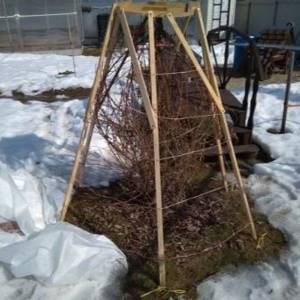
Many gardeners plant evergreen thujas in tubs. In winter, plants are removed indoors or covered with non-woven material. As a rule, there is drainage installed at the bottom of the container, which perfectly helps to retain moisture in the pots. Simply water the plant and cover it with a cotton bag, securing it around the trunk with wire or rope. It is important to know that a coniferous tree will not be able to survive the winter in a dark and damp room. In winter, thujas growing in tubs require certain conditions.
- The optimal temperature should not exceed +5 degrees. If the thermometer in the room drops to -3, then the pots are additionally insulated.
- Regular watering. In winter, the soil in the tubs should not be allowed to dry out. This will cause the tree needles to yellow and fall off.

Also, thuja in containers overwinters well on a glazed balcony. Caring for the plant will not be difficult. The tree will be able to receive the necessary lighting and fresh air. Before the onset of frost, the plant is watered abundantly and wrapped in craft paper. Throughout the winter, water is periodically poured into the bowls located under the pots. The permissible room temperature should not exceed +12 degrees.
When to cover
To preserve the beauty of ornamental plantings, it is necessary to carefully prepare for their wintering. It is necessary to start preparing thuja for rest from the beginning of August, when any feeding of the plant is stopped. If this is not done, the needles will continue to grow actively, and the branches will not be strong enough before the onset of frost.
Before covering the tree, it is recommended to prune and shape the crown, and in early autumn, carry out a one-time abundant watering with the addition of root-forming preparations, which will strengthen the root system. Young plants especially need this kind of watering. However, you should not be overzealous, as excessive watering can lead to rotting or freezing of the roots.
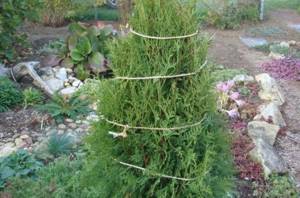
Experienced gardeners recommend covering thuja at the end of autumn, when the weather remains cloudy without precipitation and the air temperature drops no lower than +4 °C. If you prepare the plant for rest without following this rule, then there is a chance that winter will be a difficult test of endurance for your beauty.
Before preparing the thuja for rest, it is necessary to clean the crown of withered needles and carry out routine treatment of the coniferous tree against fungal diseases and pests. This treatment is carried out in two stages, which will protect the plant.
Covering materials and features of their use
If you have a small thuja growing, then you can use improvised means, for example, a plastic bottle, to cover it
However, this option is not suitable for large plants, and here it is important to determine what materials can be used, their advantages and disadvantages
Before covering the thuja, it is necessary to protect the crown from falling apart, especially if the plant consists of several trunks or has a spherical shape. To do this, use a rope made of natural fibers. They tie it around the lower part of the trunk and gradually wrap it around the entire crown of the coniferous plant using spiral movements. In this way, you can strengthen the crown of both small and large plants. If it is not possible to tie a tall thuja completely, then you can do it to the height of your height.
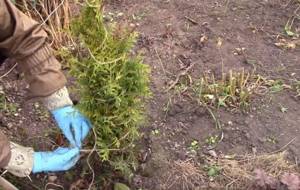
Cover the crown with:
- nonwoven materials, for example, agrofibre, lutrasil, spunbond, agrospan,
gauze, burlap, craft paper.
The choice of nonwoven material must be approached very seriously. The material must be chosen thin enough so that the plant can breathe well, therefore, polyethylene is not used to cover the thuja. Using a stapler, bag-like covers are formed from the material according to the size and shape of the plant. Modern manufacturers have already solved the problem of forming such covers, so there is a wide range of thuja covers made from such materials on sale.
Another material for crown protection can be kraft paper. They start wrapping the crown from the top and spiral down to the base. Such material must be overlapped, and fixation is carried out using a stapler and rope.
Frame structures are used to insulate young plants. You can make them yourself or purchase ready-made options. To form a frame support at home, you will need thick slats, bars, thin plastic tubes, wire and metal corners.
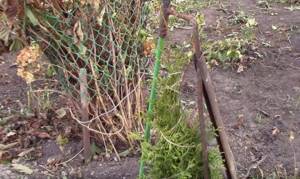
For small-sized thujas, structures with three supports are used; for larger plants with a spreading crown, structures with 4 supports are used. The length of the frame leg should be at least 2/3 of the height of the thuja, and for better fixation they are driven into the ground to a depth of 20 cm. If there is enough material, a structure can be made taking into account the capture of the crown top. Crossbars and connecting posts are used to secure the material.
A cover made of protective material, for example, an agrofibre cover, is put on the frame. It is pulled onto the frame, and the fastenings are fixed to the horizontal planks and the bases of the racks.
When using a spherical structure made of thin pipes, the upper part is fixed with twine, wire or a cross connection (for a structure made of metal-plastic pipes). This shape of the frame facilitates the rolling of snowdrifts.
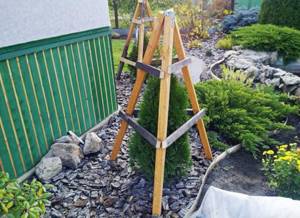
If you don’t have enough time to create a frame, you can purchase ready-made structures in specialized stores. There you can choose a frame of the desired shape and from any material. The frame design allows you to protect the plant not only from large amounts of precipitation, but also protects the roots well from freezing.
When and why is shelter needed?
Thuja is a frost-resistant plant, which in most cases does not require additional insulation. But there are certain varieties of shrubs that are not able to survive severe frosts without shelter. Young trees under 2 years of age also need protection. However, it is not only frost that poses a threat to conifers. The scorching rays of the sun are also destructive, because they can simply burn the plant.

Preparing the conifer for winter should begin in early autumn. During this period, the dose of feeding the plant is reduced, otherwise it will continue active life and will not “hibernate” in time. The sheltering procedure is carried out with the onset of stable cold weather. But it is worth remembering that the air temperature should not be lower than +4 °C. Otherwise, the plant, wrapped in heat-insulating material, may rot.
Before insulation, the crown is cleaned of damaged, rotten, and dried needles. After this, the waste is burned, as it may harbor pests and fungal diseases.
How to properly cover thujas for the winter: protect from snow and sun
Basic rules for covering thuja for the winter:
- Under no circumstances should you use cellophane or polyethylene film, as it does not allow air to pass through and may prevent the plant from growing under it.
- To protect against snow adhesion, non-woven covering materials that allow air to pass through are ideal.
- However! Many special non-woven covering materials that allow air to pass through, for example, agrofibre, spunbond, lutrasil, also allow ultraviolet rays to pass through! They can cover you from the snow, but they won’t be able to protect you from the sun, so the thuja will definitely get burned under them.
Mulching the tree trunk circle
Before covering the thuja, it is very important to mulch the soil around the tree trunk. Almost any loose material can be used as mulch: peat, pine litter, conifer bark, compost, humus, sawdust, dry leaves
The thickness of the mulch layer is 5-10 cm
Almost any loose material can be used as mulch: peat, coniferous litter, coniferous tree bark, compost, humus, sawdust, dry leaves. The thickness of the mulch layer is 5-10 cm.
Mulch will help retain moisture (reduce its evaporation) and protect the root system of still young conifers, in which it is not yet very well developed and may freeze if the winter is very frosty and snowless.
Video: insulating thuja seedlings for the winter
1 way of shelter (circular strapping)
- You can simply tie the thuja in a circle with twine (it’s better to go first from the bottom up, and then from the top down), bending the side branches to the main trunk.
- Or you can wrap the thuja with covering material, and then secure it firmly by tying it with twine.
3rd way of covering (ready-made covers)
You don’t need to erect or tie anything, you just need to buy ready-made cone covers - walk around and quickly put them on all the conifers.
4 way of shelter (protective screen)
The best and most effective way to protect thuja from sunburn is to use sunscreens. For example, you can put up supports and stretch special sun-protection materials on them or come up with something similar (as in the picture).
Thus, it is very important to carefully prepare and cover for the winter the young thujas that you recently planted on your site, but do not forget about adult conifers, which also require protection from burning out in early spring. Video: how to prepare coniferous plants (including thuja) for winter and cover (protect) from the sun
Video: how to prepare coniferous plants (including thuja) for winter and cover (protect) from the sun
Features of sheltering certain types of trees
When creating a shelter, not only the growth, but also the shape of the tree is taken into account. Globular thujas especially need shelter - the tree has sweeping branches. In heavy snowfalls they may become damaged or break. It is easier to cover columnar thujas - small trees can be easily wrapped in spunbond or covered in a cover.
Protection of young thuja
A seedling of the first year of life can be covered with a 5-liter bottle
You need to cut off the bottom and carefully place the bottle on the plant. The edges of the container should touch the mulch layer
A small thuja can also be covered with a wooden box.
Covering a cypress tree for the winter. Description
Cypress (Chamaecyparis) is a genus of evergreen coniferous trees that belongs to the Cypress family (Cupressaceae). Although the homeland of Cypress is North America and East Asia, this plant is now found in decorative form in other regions, because many varieties are quite frost-resistant, hardy and can easily be transplanted. Since the 20th century, various forms of Cypress have beautifully decorated any gardens, and more recently even indoors, as they are successfully grown in container culture. Some even use Cypress instead of a Christmas tree. Trees growing in nature can reach a height of 70 cm, and decorative forms - on average 20-40 cm. The slender trunk of Cypress is covered with scaly bark of brown or brown color. The branches are drooping or outstretched; their originality and characteristic feature is the ability to mutate.



